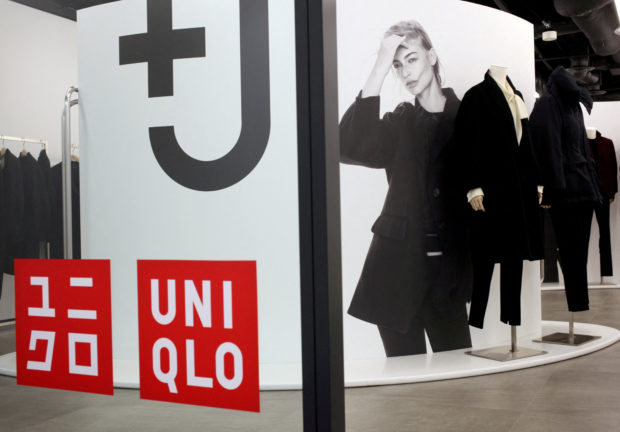Amid US retail gloom, Uniqlo shines on COVID-triggered revamp

Clothes of the collaborative label +J from Uniqlo’s new tie-up with German designer Jil Sander, are displayed at the retailer’s press room in Tokyo, Japan. REUTERS/Ritsuko Ando/File Photo
TOKYO – Just as inflation ravages the big guns of U.S. apparel retail, awash in high inventory and deep discounts to lure shoppers back to stores, Japan’s Uniqlo is set for its best year ever in North America after a COVID-imposed revolution in its business model.
Retailers from Gap to Kohl’s are warning of slumping profit margins as inflation-wary customers hold off on buying clothing. But the flagship brand of Fast Retailing said it’s poised to book its first annual profit in North America – after 17 years of trying – aided by a revamp of its logistics and pricing strategy, introduced during the pandemic, and essentially halting discounting.
Fast Retailing didn’t say how much it will make from its 59 Uniqlo stores in the region, 43 of which are in the United States with 16 in Canada. The number will be small compared with the 290 billion yen ($2.1 billion) analysts polled by Refinitiv expect it to book in overall operating profit for the 12 months ended August from more than 3,500 group stores around the world.
But its customer base is declining in ageing Japan, and concerns are increasing about how much it can rely on China as a growth engine. Analysts say whether Fast Retailing can sustain progress in North America will be a key gauge of how close it can get to its lofty goal of overtaking Spain’s Inditex as the world’s leading apparel retailer, set by founder and chief executive Tadashi Yanai.
“Uniqlo has a lot to prove over the next few quarters and years before we can have any confidence that North America can successfully replace China as Uniqlo’s next growth market,” said LightStream Research analyst Oshadhi Kumarasiri, who publishes on the Smartkarma platform.
Article continues after this advertisementFast Retailing’s North America chief Daisuke Tsukagoshi, 43 but already a 20-year company veteran, told Reuters in an interview that Uniqlo used the pandemic as a chance to “scratch everything” and start over in North America. Critically, Uniqlo stopped almost all discounting, essentially retraining its customers to get used to flat pricing.
Article continues after this advertisement“Our competitors offer discounts of 50% or 60%, but we have basically stopped that,” Tsukagoshi said.
Instead, the company has put renewed focus on basic clothing items like loungewear and lean inventory management, setting up an automated warehousing system that linked inventory at its physical stores and e-commerce shops.
A great deal?
Uniqlo has also increased use of more expensive air freight to cut lead times for popular items and avoid logistics snarls caused by the pandemic. Adidas and Lululemon Athletica are among others who have upped use of air transportation to get around seaport bottlenecks.
“We’re trying to get products into the warehouse in the shortest possible time, even if we have to use air,” said Tsukagoshi.
It’s not clear how much the company’s operations have benefited from the yen trading at its lowest level in decades. U.S. revenue is worth much more translated into the Japanese currency, but the cost of buying materials in yen is now much higher.
Away from the warehouse, the company’s stores are looking brighter and more attuned to American tastes than before, said Neil Saunders, a retail analyst at GlobalData. But Uniqlo may have misread the market by swearing off discounting.
“Low prices are interesting to the U.S. consumer and they do work, but sometimes people like those bargains, and getting a sense they’re getting a great deal,” he said.
“And Uniqlo doesn’t necessarily offer that.”
Xinjiang a risk?
Uniqlo, best known for its fleeces and inexpensive basics, first entered North American in 2005 and now plans to open 30 stores a year until it reaches 200 in the next five years, branching out of major cities like New York and San Francisco along the way into more spread-out locales, like Texas and Florida.
The company estimates the region will produce 300 billion yen in annual sales by 2027, and aims to raise operating profit margins to 20% from more than 5% now. Regional chief Tsukagoshi said that will be possible by reducing logistics and marketing costs, and also via lower rents beyond large cities.
Some are skeptical.
The expansion and profitability goals appear “a bit too ambitious” as Fast Retailing hasn’t reached 20 percent margins even in its home market of Japan, said LightStream Research analyst Kumarasiri.
One risk to the company’s plans could lie in its dependence on manufacturing in China, where human rights concerns have swirled around labor and cotton produced in the Xinjiang region.
While there has been no sign of a U.S. consumer boycott so far, Fast Retailing has not disavowed the use of Xinjiang cotton, unlike rivals including Sweden’s H&M. A shipment of Uniqlo shirts was blocked at the Port of Los Angeles last year on suspicion of violating a ban on the material.
Also, French prosecutors last year opened an investigation into the company and three other retailers suspected of concealing “crimes against humanity” in Xinjiang. Prosecutors didn’t respond to a request for comment, and it wasn’t immediately clear what stage the investigation has reached.
The company has denied the allegations and has said it doesn’t tolerate human rights violations among suppliers and vendors. China denies all accusations of abuse in the region.
($1 = 139.5000 yen)